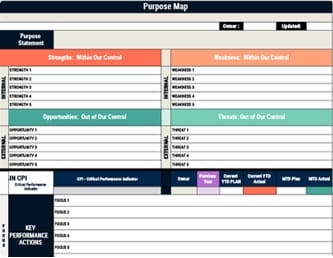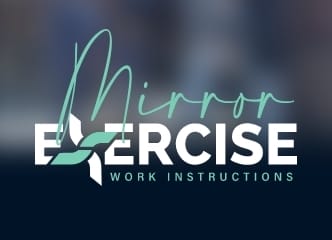If you’re a mid-market CEO, you need a crisp strategy that aligns where you’ll compete (Arenas), how you’ll get there (Vehicles), why you’ll win (Differentiators), when to scale (Staging and Pacing), and how you’ll make money (Economic Logic), because coherent choices drive results; use VRIO to test resource advantage, the Value Stick to expand profit and WTP, the Strategy Diamond for trade-offs, and clear execution metrics to keep it real—so here’s how to put it together.
Key Takeaways
- Use VRIO to audit resources, confirming value, rarity, imitability, and organizational readiness for sustained advantage.
- Apply the Value Stick to expand margins by increasing customer WTP and lowering supplier/employee WTS.
- Align choices with the Strategy Diamond: arenas, vehicles, differentiators, staging, and economic logic.
- Balance investments with McKinsey’s Strategic Horizons: 70-20-10 across core, emerging, and future initiatives.
- Drive execution via aligned metrics, regular communication rhythms, and visual management to maintain focus and accountability.
VRIO Analysis for Resource-Based Advantage
Although strategy frameworks can feel abstract, VRIO gives you a practical lens to audit what truly drives your edge by asking four disciplined questions about each resource and capability: Is it Valuable, is it Rare, is it costly to Imitate, and is your Organization set up to capture its full benefit?
Use VRIO Analysis to inventory your resources and capabilities, then test each one. Confirm it’s valuable by showing how it exploits an opportunity or neutralizes a threat, not by intuition.
Check rarity by benchmarking how many rivals control similar assets. Probe imitability by estimating time, cost, and know-how required to copy, including patents, culture, or data.
Finally, verify organization—governance, incentives, processes, and talent—so valuable, rarity-rich assets convert into durable competitive advantage.
To ensure VRIO insights translate into results, connect them to aligned OKRs and governance rhythms so resources are prioritized, tracked, and adapted through execution.
The Value Stick to Expand Profits and Willingness-to-Pay
Something simple but powerful helps you see where profits actually come from: the Value Stick, which maps four anchors—customers’ willingness to pay (WTP), employees’ and suppliers’ willingness to sell (WTS), your price, and your unit cost—to show who captures value and where you can expand it.
You raise willingness to pay by improving features, service, and branding, which increases customer satisfaction and supports premium pricing strategies; Starbucks’ 2022 results show how branding can lift revenue through higher WTP.
Boost WTP through superior features, service, and branding—Starbucks shows branding’s power to lift revenue.
You widen profit margins further by lowering willingness to sell through smarter sourcing, process efficiency, and cost management, without eroding perceived value.
Run targeted customer surveys to estimate WTP accurately, then test price moves carefully. Track the gap between WTP and WTS to quantify value created and guide investment. Aligned organizations that strengthen both vertical and horizontal alignment improve collaboration and productivity, accelerating revenue growth and profitability.
Strategy Diamond for Coherent Choices and Trade-offs
When you need a single lens to align choices and trade-offs, use the Strategy Diamond, a framework that ties five elements—Arenas, Vehicles, Differentiators, Staging and Pacing, and Economic Logic—into one coherent plan. You clarify Arenas to decide where you’ll compete, matching capabilities to market opportunities and avoiding distracting detours. You select Vehicles—partnerships, acquisitions, or organic growth—to scale efficiently, balancing control, speed, and risk. You define Differentiators to win on value, using product features, brand, or service to build a durable competitive edge. You set Staging and Pacing to sequence moves, aligning resources, timing, and milestones. To keep these choices cohesive and adaptive, reinforce them with continuous communication and feedback loops that sustain organizational alignment across teams and time. – Specify Arenas that fit your strengths and demand. – Choose Vehicles that accelerate strategy and growth. – Anchor differentiation and timing to clear Economic Logic.
McKinsey’s Strategic Horizons to Balance Now, Next, and New
Balance is your operating principle with McKinsey’s Strategic Horizons, a simple portfolio lens that separates initiatives into Horizon 1 (protect and optimize the core), Horizon 2 (scale emerging bets), and Horizon 3 (seed future options), so you can deliver today while building tomorrow.
You align your business to a 70-20-10 resources allocation: 70% to core operations and product lines that fund the enterprise, 20% to emerging opportunities with rising market growth, and 10% to future innovations that expand optionality.
You set targets by growth rate and risk, then prune or scale based on evidence. In Horizon 2, you lean on data-driven screening, run disciplined experiments, and double down where adoption and unit economics improve.
Companies make this balance tangible; Amazon’s e-commerce, AWS, and new bets illustrate the model. As proof that alignment drives results, leaders like Tesla, Airbnb, and PayPal translated strategy into execution through clear objectives and OKRs, regular feedback loops, and cross-functional collaboration.
Execution Metrics and Communication Rhythms That Drive Results
Although strategy sets direction, you only deliver results when execution metrics and communication rhythms work together to focus attention, reinforce priorities, and trigger the right behaviors.
Tie execution metrics to explicit communication goals so every KPI signals whether messages land, drive employee engagement, and advance organizational progress.
Publish a concise “view from 30,000 feet” update on a reliable cadence, translating strategy into what teams should start, stop, and continue, while highlighting wins and risks.
- Use segmented channels—town halls, manager toolkits, and targeted emails—to improve message effectiveness and retention.
- Run quarterly employee engagement surveys, then connect findings to behavioral changes, such as adoption rates, cycle times, and quality trends.
- Define communication outcomes upfront, set baselines, and review results in operating meetings to refine rhythms and close gaps.
Integrate visual management tools to enhance transparency and real-time feedback, using Kanban boards and color-coded Andon signals to surface bottlenecks quickly and reinforce accountability.
Frequently Asked Questions
What Strategy Frameworks Do Top CEOS Use?
Top CEOs use VRIO to judge resources’ value, rarity, imitability, and organization, then apply the Strategy Diamond to clarify arenas, vehicles, differentiators, staging, and economic logic.
You’d track execution with a Balanced Scorecard, aligning financial and non-financial metrics, and prioritize portfolios using the BCG Growth-Share Matrix.
You’d also balance time horizons with McKinsey’s Three Horizons, while complementing these with SWOT, Porter’s Five Forces, and OKRs for alignment and accountability.
What Are the Five Components of a Business?
The five components of a business are Vision, Mission, Values, Strategy, and Culture.
Picture your company as a ship: you steer with Vision, you justify the voyage with Mission, you uphold conduct with Values, you chart routes with Strategy, and you sustain morale with Culture.
You define Vision to align direction, craft Mission to express purpose, codify Values to guide decisions, build Strategy to allocate resources, and shape Culture to drive engagement.
What Is the CEO Framework?
The CEO Framework is a practical system of five components—Focus, Communication, Motivation, Empowerment, and Values—that you use to align strategy and execution.
You define a clear mission and priorities to filter distractions, communicate consistently so messages resonate, balance autonomy with transparency to raise morale, invest in hiring and developing talent rather than churn, and model values visibly.
Together, these elements drive alignment, accountability, and sustained performance across your organization.
What Is a Business Strategy Framework?
A business strategy framework is your roadmap for analyzing where you stand, deciding where to go, and aligning resources to get there, like a compass cutting through fog.
You use tools such as SWOT and Five Forces to assess strengths, risks, and market dynamics, then translate insights into clear goals, priorities, and metrics.
It standardizes language, streamlines decisions, and improves execution, helping you focus efforts, sequence initiatives, and adapt as conditions change.
Conclusion
You now have a practical frame: define arenas, pick vehicles, sharpen differentiators, sequence staging, and anchor economic logic, then pressure-test with VRIO, the Value Stick, the Strategy Diamond, and McKinsey’s Horizons. Set clear execution metrics and communication rhythms to keep alignment tight. Remember, companies that revisit strategy quarterly are 33% more likely to hit targets, so schedule the cadence, review trade-offs, and adjust pacing, ensuring resources move first to the highest-return bets while risks stay visible and managed.



